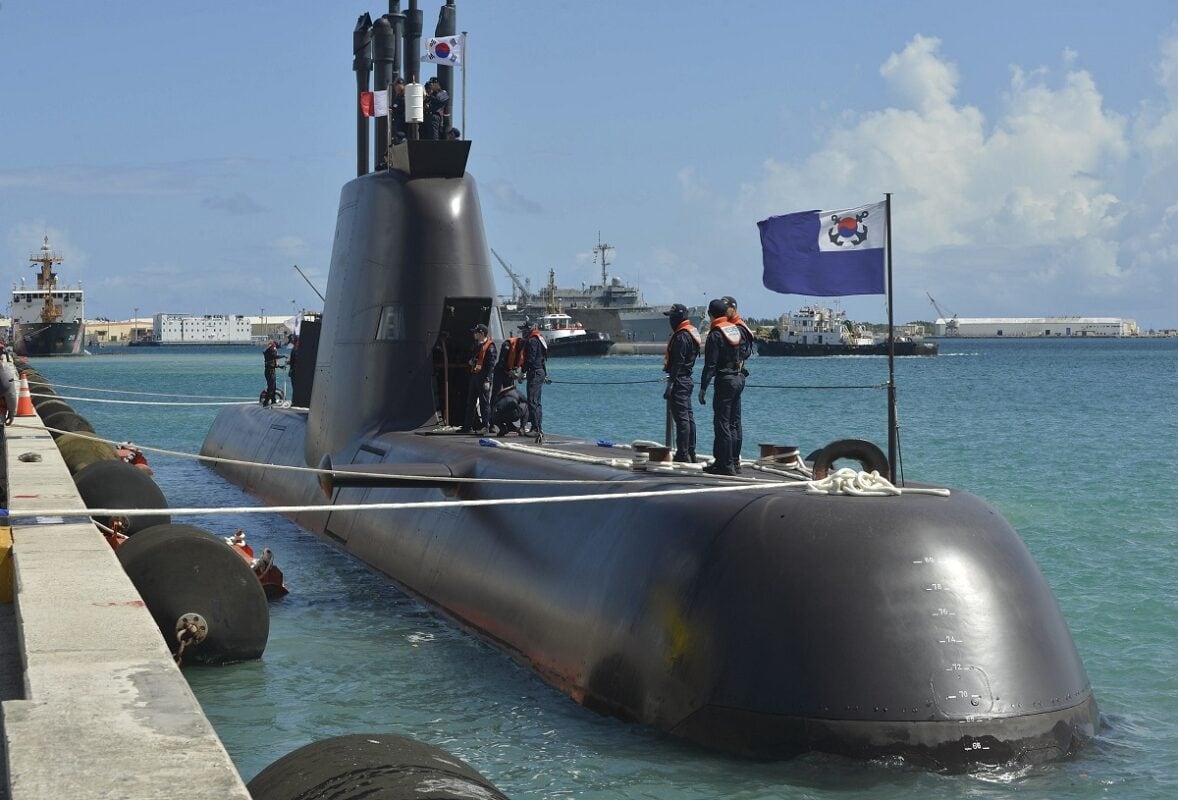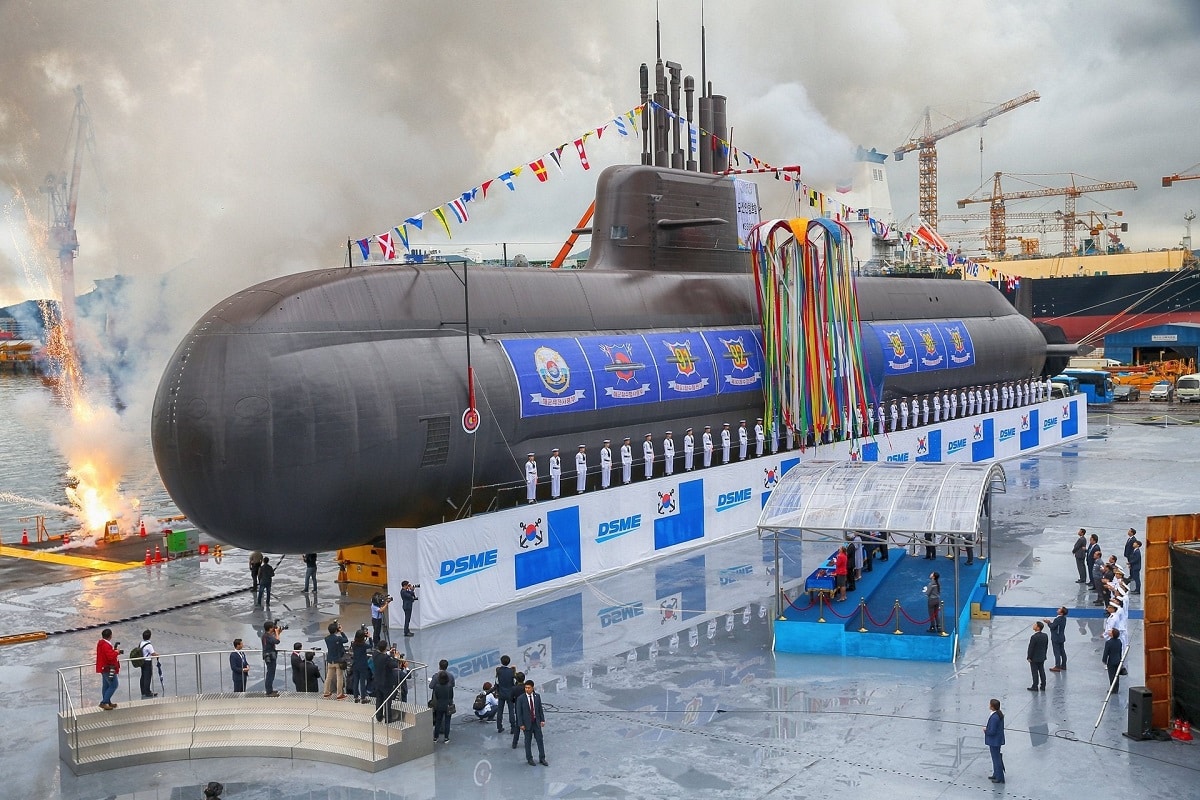South Korea’s Submarine Fleet Is a Powerhouse: After publishing a piece on the Democratic People’s Republic of Korea’s submarine fleet (aka North Korea), it’s appropriate for us here at 19FortyFive to follow up by examining the submarine capabilities of America’s faithful friend and ally on the Korean Peninsula, the Republic of Korea. The ROK Navy has a total of 22 submarines either in operational service or under construction, spread out across three different classes. Let’s take a deeper dive into each class.
KS-III AKA Dosan Ahn Changho-class
The newest and largest sub class in South Korea’s navy is also their first locally developed, diesel-electric attack submarine capable of deploying submarine-launched ballistic missiles (SLBMs).
A total of nine KS-IIIs are planned, spread out across three batches. The first of the bunch, Dosan Ahn Chang-ho (pennant number SS 083), officially entered into service on Aug. 13, 2021 at the facilities of Daewoo Shipbuilding and Marine Engineering (DSME) at Okpo on Geoje Island. According to Janes:
“Equipped with locally made lead-acid batteries and an air-independent propulsion (AIP) system featuring hydrogen fuel cells, Dosan An Chang-ho is expected to be operationally deployed from August 2022 after undergoing a series of operational performance and capability evaluations, according to an RoKN statement..Fitted with noise-reduction technology, the submarine, which displaces 3,358 tonnes when surfaced and 3,705 tonnes when submerged, has a stated maximum speed of about 20 kt, a cruising range of 10,000 n miles, and can accommodate a crew of 50, according to Janes Fighting Ships.”
The Batch-I KS-IIIs have a hull length of 83.5 meters and a beam of 9.6 meters. Armament consists of six 533mm torpedo tubes that accommodate the LIG Nex1 Tiger Shark heavyweight torpedo, along with six Korean Vertical Launching System cells for launching the Hyunmoo 4-4 SLBM.
Son-Won II (Type 214) Class
The Son-Won II boats are the second-newest subs in the ROKN fleet. The first sub was commissioned in 2008, and the class culminated in September 2017 with the launch of its ninth ship, ROKS Shin Dol Seok. According to the Nuclear Threat Initiative website, “The Son Won-II-class is a hybrid diesel‐electric/fuel cell submarine with AIP technology. They are 65 meters long with a 6.3-meter-wide beam and can travel up to 20 knots when submerged. They can remain submerged for about 50 days without surfacing. Their weapons systems are capable of firing torpedoes and anti-ship missiles.”
The Son-Won IIs were built under license from Germany’s Howaldtswerke-Deutsche Werft (HDW). Surface displacement is 1,660 tons, and the subs wield eight 533mm torpedo tubes. The crew complement is five commissioned officers and 22 enlisted sailors.
Chang Bogo Class (Type 209/1200)
The Chang Bogo boats comprise the oldest and smallest sub class in the ROKN fleet, but they’re still quite capable. As with the Son Won II-class, they were built under license from Germany’s HDW. The ROKN has a total of nine such boats, beginning with the Chang Bogo (SS-061) which was commissioned in 1993, and concluding with the Yi Eokgi (SS-071) in 2001. The warship class is named for ancient Korean maritime hero Chang Bogo (787-841).
Per Nuclear Threat Initiative , “These submarines are 56 meters long with a 6.2-meter-wide beam and can travel up to 21.5 knots when submerged. They can remain submerged for about 50 days without surfacing. Their weapons systems are capable of firing torpedoes.”
The torpedoes in question are the German-made AEG SUT 264 533mm heavyweight torpedo, and the Chang Bogos have eight launchers to accommodate them. What the NTI report fails to mention is that some of the members of this sub class are also capable of launching the UGM-84 SSM Harpoon anti-ship missile.
The Chang Bogo subs have a surface displacement of 1,200 to 1,400 tons and hold a crew complement of 33.
Looking forward
As noted by Tim Fish in a December 2021 article for UNSI News, “The Republic of Korea Navy is no longer solely focused on the threat from its northern neighbor, but is embarking on an expansion to build a fully-fledged blue water fleet… the South Korean Navy is in the process of building up its surface fleet and increasing the capability of its submarines to provide more offensive firepower and conduct wider regional engagements.”

SANTA RITA, Guam (June 5, 2019) – Republic of Korea Navy sailors aboard the Sohn Wonyil class diesel-electric submarine ROKS Yun Bonggil (SS 077), prepare to conduct line handling duties as the submarine arrives at Naval Base Guam, June 5. Naval Base Guam is strategically located to support all submarines deployed to 7th Fleet and is home port to four Los Angeles-class attack submarines. (U.S. Navy photo by Mass Communication Specialist Seaman Chase Stephens /Released)
To that effect, rumors abound that the ROKN is planning on building a nuclear submarine, unofficially termed the KSS-N. As stated by Naval News reporter H.I. Sutton, “ On November 10 [2021] local media reported on plans to start work on an indigenous nuclear reactor. The multipurpose system is described in civilian terms. But observers have been quick to make the association to a South Korean Navy (ROKN) nuclear submarine program… It is no secret that South Korea has an interest in building nuclear submarines. It has been an open discussion for nearly twenty years and AUKUS has only reinvigorated it. And South Korea now has the submarine building industry, and nuclear industry, to do it.”
Christian D. Orr is a former Air Force Security Forces officer, Federal law enforcement officer, and private military contractor (with assignments worked in Iraq, the United Arab Emirates, Kosovo, Japan, Germany, and the Pentagon). Chris holds a B.A. in International Relations from the University of Southern California (USC) and an M.A. in Intelligence Studies (concentration in Terrorism Studies) from American Military University (AMU). He has also been published in The Daily Torch and The Journal of Intelligence and Cyber Security. Last but not least, he is a Companion of the Order of the Naval Order of the United States (NOUS). In his spare time, he enjoys shooting, dining out, cigars, Irish and British pubs, travel, USC Trojans college football, and Washington DC professional sports.

